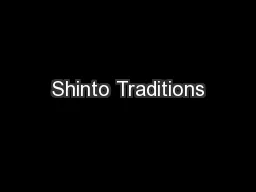

Practices Ceremonies Rituals and Festivals PRACTICES What is a Religious Practice The act of rehearsing a religions traditional moral and ethical beliefs Shinto practices commemorate kami ID: 401572
Download Presentation The PPT/PDF document "Shinto Traditions" is the property of its rightful owner. Permission is granted to download and print the materials on this web site for personal, non-commercial use only, and to display it on your personal computer provided you do not modify the materials and that you retain all copyright notices contained in the materials. By downloading content from our website, you accept the terms of this agreement.
Slide1
Shinto Traditions
Practices, Ceremonies, Rituals and FestivalsSlide2
PRACTICESSlide3
What is a Religious Practice?
The act of rehearsing a religion’s traditional, moral and ethical beliefs.
Shinto practices commemorate kami
Take place mostly in ShrinesTies in and incorporates ritualsMajor theme: purification (the act of removing uncleanliness to show devotion to the kami)
Shinto PracticesSlide4
Shinto’s main religious practice
Omairi
means “participation”
Done by visiting ShrinesWay of paying respect to kamiOmairiSlide5
Rite of ritual purification (major theme in Shinto religion)
Ceremony of offerings and prayers of many forms
HaraeSlide6
Means water purification
Practice of purification
Done whilst reciting prayers (defined to this particular practice)
Mostly performed in Shrines or natural settingsMisogiSlide7
Ancient Shinto dance
Means “seat of the kami”
Aim is to entertain the kami
Involves a lion mask as image and presence of deityKaguraSlide8
Test Yourself
What is a major theme in Shinto practices?
What is the meaning of
Omairi? Which practice involves an Ancient Shinto dance being performed?
What are the aim of practices?
Where do they mostly take place? Slide9
What is a major theme in Shinto practices?
Purification
What is the meaning of
Omairi? ParticipationWhich practice involves an Ancient Shinto dance being performed? Kagura
What are the aim of practices?
To commemorate the kami
Where do they mostly take place?
Shrines
Test Yourself AnswersSlide10
CEREMONIESSlide11
What are Religious Ceremonies?
Religious ceremonies is a formal religious occasion, typically celebrating a particular event of great significance
Spirituality of Shinto revealed through ceremonies
Remained unchanged for thousands of yearsAllow adherents to celebrate
and give gratitude
in order to
live joyful and productive lives as part of Divine Nature
Enhances connection with the kami
Cover significant life events
Performed by Shinto priests
Shinto CeremoniesSlide12
Cover a range of personal and social concerns
Builds closer connection with the kami
Kito
(Prayer Ceremonies)Slide13
HATSUMIYAMAIRI 1st shrine visit of a newborn baby
SHICHI-GO-SAN
MAIRI
ceremony for boys ages 3 and 5 and girls ages 3 and 7 to pray for continued health and safe growth and developmentSEIJINSHIKI coming of age rite (age 20)SHINZEN KEKKON SHIKI Wedding Ceremony
Jensei
Girei
(Life Cycle Rites)Slide14Slide15
Most significant ceremony in Shinto religion
Initiates individuals, welcoming them into adult Japanese society
Represents an important milestone
Coming of Age CeremonySlide16
The following link below shows an example of a Shinto ceremony.
http://www.youtube.com/watch?v=R__
jKqJcUso
Watch carefully and note any distinctive features you see.
Shinto Ceremonies in ActionSlide17
What is the major aim of ceremonies?
What is revealed through these ceremonies?
Name three major ceremonies in the Shinto Religion.
Name the most significant Shinto ceremony.Who are they conducted by?
Test YourselfSlide18
What is the major aim of ceremonies
?
Enhances connection with kami
What is revealed through these ceremonies? Spirituality of ShintoName three major ceremonies in the Shinto Religion. *Can be any of the ones mentioned above*
Name the most significant Shinto ceremony
.
Coming of Age Ceremony
Who are they conducted by
?
Shinto Priests
Test Yourself AnswersSlide19
RITUALSSlide20
What are Religious Rituals?
Religious rituals consist of a series of actions performed according to traditional order
Taking part in rituals beings Shinto unites community
Entertain the Kami and peopleCommunication with the kami takes place hereMost common type involve purification; life cycle rituals also prominent themes
Shinto RitualsSlide21
Rituals examined on number of levels including:
Jinja
Shinto-
takes place at ShrinesMinzoku Shinto- relates to folk religion in JapanKoshitsu Shinto- practiced at national level
Refer to the “Shinto Practices” slides for specific rituals carried out by Shinto adherents
Shinto Rituals
cont.Slide22
Rinsing of mouths and washing of hands
Worshippers proceed to
Haiden
(prayer hall)Clap their hands 2 times (alerts kami)Devotees bow deeply in respect of kami
Entering the ShrineSlide23
Place the following images in order in which Shinto adherents enter shrines.
Activity:Slide24
Answers
1.
2
.
3
.
4
. Slide25
FESTIVALS
“
Matsuri
”Slide26
What are Religious Festivals?
Religious festivals are days or periods of celebration to commemorate something in particular
Vary from community to community
Features dancers, boats and bonfiresTypically involve food offerings, procession of kami in palanquins and ritual prayersIncludes visits to local shrines
Shinto FestivalsSlide27
A large festival with large attendance
Involves people thinking about the kami and making resolutions for New Year
Oshogatsu
-New YearSlide28
Coming of Age celebration
Sejin
Shiki-Adults DaySlide29
Festival surrounding the planting of crops
Spring is a time of many
festivities
Yellow and red are typically worn (to represent presence of the kami in Spring)Haru Matsuri- Spring FestivalSlide30
A time to thank the kami for a good
harvest
Blue and red are typically worn (to represent the presence of the kami in Autumn)
Aki Matsuri- Autumn FestivalSlide31
This is when parents give thanks and appreciation for the life of their children
Pray for their futures
Visit the local Shrine
ShichigosanSlide32
Annual festivalCelebrated on day relevant to Shrine in which it takes
place
White is usually worn by adherents on this day
Rei-SaiSlide33
As a class place the following images in the most appropriate slide.
Activity:
1.
2
.Slide34
3
.
4
.
5
.
6
.Slide35
1.
Haru-Matsuri
2.
Sejin Shiki3. Shichigosan4. Oshogatsu
5.
Rei
-Sai
6.
Aki
Matsuri
Answers